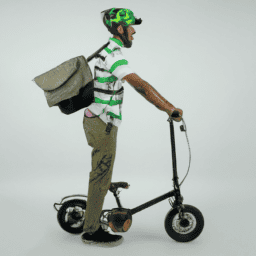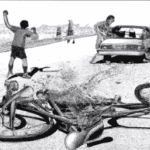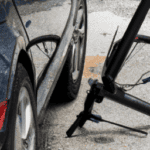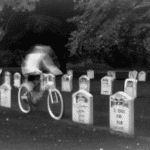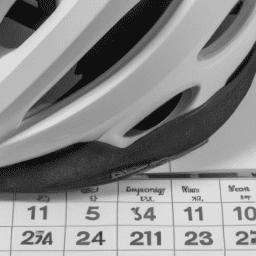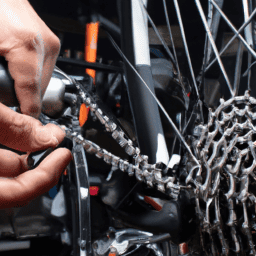As someone who rides a bicycle, I’m intimately aware of the hazards that come with sharing the road with automobiles. A single moment of inattention from a driver or a brief lapse in judgment can lead to an accident.
But what happens when a bicycle hits a car? It’s a question that many cyclists and drivers may wonder, and one that I hope to answer in this article.
According to statistics from the National Highway Traffic Safety Administration, the majority of bicycle accidents involve collisions with motor vehicles. These collisions can result in serious injuries or even fatalities, both for the cyclist and the driver of the car.
Understanding what happens during a bicycle-car collision can help both cyclists and drivers take steps to prevent these accidents from happening in the first place. So let’s dive into the factors that impact the severity of the collision and the injuries sustained by both parties involved.
Key Takeaways
- Bicycle accidents involving cars can result in a range of injuries, including head injuries, broken bones, and internal injuries.
- Wearing a helmet can significantly reduce the risk of head injury by up to 88%.
- Preventing accidents involves obeying traffic laws and using protective gear, as well as practicing defensive driving to avoid collisions with cyclists.
- After a collision, it’s important to check for injuries, gather information, and document the scene to promote safety and prevent future accidents.
Factors that Impact the Severity of the Collision
You’ll feel the impact of the collision more intensely if you’re not wearing a helmet or other protective gear. However, the severity of the collision also depends on other factors.
One of the most critical factors is the speed at which the cyclist is traveling and the speed limit on the road. If the cyclist is traveling at a high speed and hits a car, the impact will be more severe. Moreover, if the car is also traveling at a high speed, the collision can be deadly.
Additionally, the condition of the road also plays a role in the severity of the collision. If the road is slippery or there are potholes, the cyclist may lose control of the bike and hit the car. In such cases, the impact of the collision can be severe, causing significant damage to both the bicycle and the car.
Injuries sustained by the cyclist will depend on the factors that caused the collision. If the cyclist was traveling at a high speed and the car was also traveling at a high speed, the injuries can be severe, even fatal. However, if the cyclist was wearing protective gear and the car was not traveling at a high speed, the injuries may be less severe.
Injuries Sustained by the Cyclist
When I think about the injuries sustained by a cyclist in a collision with a car, three primary types come to mind:
-
Head injuries can range from minor cuts and bruises to traumatic brain injuries that can have long-term consequences.
-
Broken bones are also common and can result in lengthy recovery times.
-
Finally, internal injuries can be difficult to detect and can cause serious damage if left untreated.
It’s important to note that all of these injuries can have significant impacts on the cyclist’s quality of life and may require extensive medical attention.
Head Injuries
Head injuries can be a serious consequence when a bicycle collides with a car. The impact of the collision can cause the cyclist’s head to hit the car’s windshield, hood, or any other hard surface. This can result in traumatic brain injury (TBI), which can range from mild concussions to severe brain damage.
Here are some important points to consider regarding head injuries sustained by cyclists in such accidents:
-
Common Causes: Head injuries are often caused by the cyclist not wearing a helmet. In some cases, even if the cyclist is wearing a helmet, the impact can still cause head injuries.
-
Prevention Strategies: Wearing a helmet is the most important step in preventing head injuries. Properly fitted helmets can reduce the risk of head injury by up to 88%. In addition, cyclists should always follow traffic rules, ride in designated bike lanes, and be aware of their surroundings.
As important as head injuries are, they are not the only injuries that cyclists may sustain in such accidents.
Broken bones are another common consequence of bicycle-car collisions.
Broken Bones
Broken bones are a frequent injury resulting from collisions between cars and cyclists, and wearing protective gear can help reduce the risk. When a cyclist collides with a car, the impact can cause the rider to be thrown from their bike, leading to broken bones. Commonly fractured bones include the clavicle, wrist, and ribs. In some cases, the impact can be severe enough to cause a compound fracture, where the bone protrudes through the skin.
The healing process for broken bones can vary depending on the severity and location of the fracture. In some cases, surgery may be necessary to realign the bone and secure it with pins, screws, or plates. After surgery, physical therapy is often used to help the patient regain strength and mobility in the affected area. It may take several months for a broken bone to fully heal, and during this time, the patient may need to wear a cast or brace to immobilize the area. While broken bones can be painful and require a lengthy recovery, they are often less severe than internal injuries sustained in a collision.
Moving onto the subsequent section about internal injuries, it’s important to note that these types of injuries can have more serious and long-lasting effects on a person’s health.
Internal Injuries
Internal injuries can be incredibly dangerous and have the potential to wreak havoc on the body, causing long-lasting damage that can be difficult to recover from. When a bicycle collides with a car, the impact can cause serious damage to internal organs such as the liver, spleen, and kidneys. These injuries can be life-threatening and require immediate medical attention.
Treatment options for internal injuries depend on the severity of the damage. Surgery may be necessary to repair or remove damaged organs, and patients may require ongoing medical care and rehabilitation to recover. Even with treatment, internal injuries can have long-term effects on a person’s health and well-being, impacting their ability to work, engage in physical activity, and enjoy daily life.
As we move to the next section, it’s important to consider not only the injuries sustained by the cyclist but also those sustained by the driver of the car.
Injuries Sustained by the Driver
Although the driver may not experience obvious physical trauma, they can still suffer from various injuries after a bicycle collides with their car. These injuries can range from minor cuts and bruises to more severe injuries like whiplash and even broken bones. It’s important for drivers to seek medical attention immediately after an accident, even if they feel fine, as some injuries may not show symptoms until later on.
In addition to physical injuries, drivers may also experience psychological trauma after a bicycle-car collision. It can be a traumatic experience to hit another person, especially if it results in serious injuries or fatalities. This can lead to feelings of guilt, anxiety, and depression. Furthermore, drivers may also face compensation claims from the bicyclist or their family, which can add to the stress and emotional impact of the accident. It’s important for drivers to seek support and counseling if needed to process the emotional aftermath of a collision.
Moving forward, it’s crucial for drivers to take the necessary steps after a bicycle-car collision to ensure the safety of everyone involved.
Steps to Take After a Bicycle-Car Collision
After a bicycle-car collision, the first step drivers should take is to check for any injuries and call for medical assistance if necessary, as studies show that over 70% of bicycle-car collisions result in some form of injury.
Once everyone involved is safe and out of harm’s way, it’s important to gather any necessary information such as contact details, license plate numbers, and insurance information from the other party. This information will be crucial when filing insurance claims or taking legal action if necessary.
In addition to seeking medical attention and gathering information, drivers should also document the scene of the accident by taking photos and writing down any details they can remember. This documentation can also be helpful when filing insurance claims or legal action.
It’s important to remember that even if the driver feels they were not at fault, they shouldn’t admit fault at the scene of the accident as this can impact any legal proceedings. By taking these steps, drivers can ensure that they’re protecting themselves and promoting safer cycling and driving practices.
Promoting Safer Cycling and Driving Practices
As a cyclist, I believe it’s crucial to promote safer cycling and driving practices to prevent accidents and injuries.
One way to do this is by obeying traffic laws, such as stopping at red lights and using hand signals when turning.
Another important practice is using protective gear, such as helmets and reflective clothing, to increase visibility and reduce the risk of head injuries.
Lastly, practicing defensive driving as a motorist can help avoid collisions with cyclists by being aware of their presence on the road and giving them enough space to maneuver.
Obey Traffic Laws
To stay safe on the road, it’s important to always obey traffic laws while riding a bicycle. This includes stopping at red lights and stop signs, yielding to pedestrians, and using hand signals when turning or changing lanes.
When cyclists follow traffic laws, they can help prevent accidents and reduce the risk of injury to themselves and others. Education is crucial in promoting safer cycling practices, and law enforcement plays an important role in enforcing traffic laws to ensure the safety of all road users.
In addition to obeying traffic laws, cyclists should also use protective gear to further reduce the risk of injury in the event of an accident. Wearing a properly fitting helmet can protect the head and brain from serious injury, while reflective clothing and lights can increase visibility to other road users.
By taking these precautions, cyclists can make themselves more visible and better equipped to handle any unexpected situations on the road.
Use Protective Gear
As important as it is to obey traffic laws, it is equally important to use protective gear when cycling. Whether you’re a seasoned cyclist or just starting out, accidents can happen when you least expect it. That’s why choosing proper equipment and wearing it correctly can make all the difference in preventing serious injuries.
When it comes to protective gear, there are a few key items that every cyclist should have. The most important is a helmet, which can reduce the risk of head injury by up to 85%. It’s also important to wear reflective clothing or accessories, especially when cycling at night or in low-light conditions. And don’t forget about gloves, which can protect your hands from scrapes and reduce the impact of a fall. Additionally, taking the time to properly adjust and wear your gear can make a big difference in how effective it is in protecting you.
It’s not enough to simply have the gear, however. It’s also important to know how to use it and to have the skills to safely navigate the roads. This is where training comes in. By taking a cycling safety course or practicing on your own, you can learn how to properly use your gear and develop the skills necessary to stay safe on the roads. So while obeying traffic laws and using protective gear are important steps in staying safe while cycling, it’s just as important to invest in training to become a confident and skilled cyclist.
As important as it is to use protective gear and receive proper training, it’s also crucial to practice defensive driving. This means being aware of your surroundings, anticipating potential hazards, and taking the necessary precautions to avoid accidents.
Practice Defensive Driving
Driving defensively while cycling can be a lifesaving skill, especially in high traffic areas where potential obstacles may arise unexpectedly. As a cyclist, it’s crucial to be aware of your surroundings and anticipate the actions of other drivers on the road.
Here are some tips on practicing defensive driving:
- Always assume that drivers don’t see you and be prepared to take evasive action.
- Stay visible by wearing bright or reflective clothing and using lights on your bike.
- Use hand signals to communicate your intentions to drivers and always obey traffic laws.
By adopting these defensive driving techniques, you can greatly reduce your risk of being involved in an accident while cycling. It’s important to remember that as a cyclist, you are more vulnerable on the road than drivers in cars, so taking proactive measures to avoid accidents is essential.
In addition to defensive driving, there are also strategies you can employ to avoid accidents altogether. These include:
- Avoiding blind spots of cars by positioning yourself in a visible location.
- Being aware of turning vehicles and anticipating their movements.
- Scanning the road ahead for potential hazards such as potholes or debris.
By combining defensive driving with these avoidance techniques, you can greatly increase your safety while cycling on the road. Remember, staying alert and proactive is key to avoiding accidents and arriving at your destination safely.
Frequently Asked Questions
Who is at fault in a bicycle-car collision?
Legal responsibility in a bicycle-car collision is determined by comparative negligence. Both parties may share responsibility for the accident. The specific circumstances of the collision will determine the degree of fault assigned to each party.
How common are bicycle-car collisions?
Bicycle safety is crucial, as bicycle-car collisions are alarmingly common. Accident statistics show that these incidents can result in severe injuries or even fatalities. It’s important to promote awareness and prevention measures to minimize such occurrences.
Can a cyclist file a personal injury lawsuit against the driver?
If I am a cyclist involved in a bicycle-car collision, I may be able to file a personal injury lawsuit against the driver for compensation. This involves a legal process that requires evidence of the driver’s negligence.
What should drivers do to prevent bicycle-car collisions?
As a driver, I prioritize the safety of all road users. It’s crucial to understand the importance of bike infrastructure and receive education on sharing the road. These measures can prevent collisions and protect vulnerable cyclists.
What are the legal implications for the driver in a bicycle-car collision?
If I am involved in a bicycle-car collision, legal consequences may include fines, license suspension, or even jail time if found at fault. Insurance coverage may also be affected, resulting in higher premiums or denial of coverage.
Conclusion
As a cyclist, I know firsthand the dangers of sharing the road with cars. The impact of a bicycle hitting a car can be devastating, and the severity of the collision depends on several factors such as speed, angle of impact, and the use of protective gear.
Injuries sustained by both the cyclist and the driver can range from minor cuts and bruises to life-threatening injuries. It’s crucial to take immediate steps after a collision, including seeking medical attention and contacting an experienced personal injury lawyer.
Promoting safer cycling and driving practices is essential to prevent accidents on the road. We must all do our part to ensure the safety of ourselves and others.
Remember, a moment of carelessness can have a lifetime of consequences. So let’s all be vigilant and responsible while on the road, as our lives and the lives of others depend on it.

